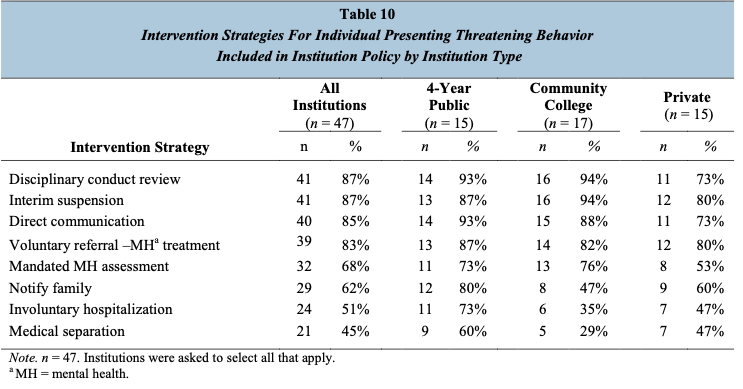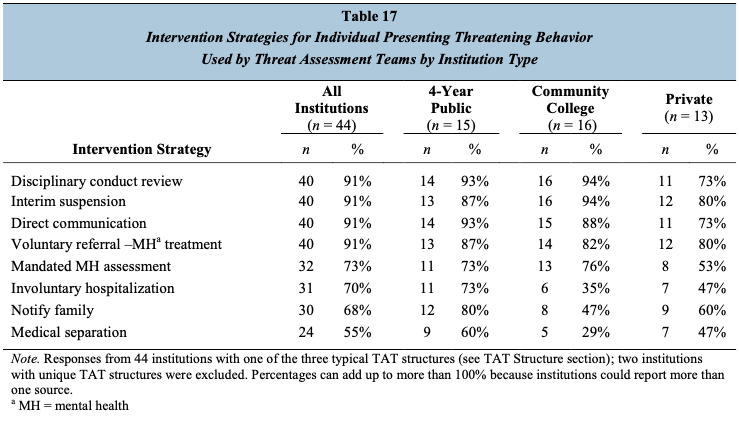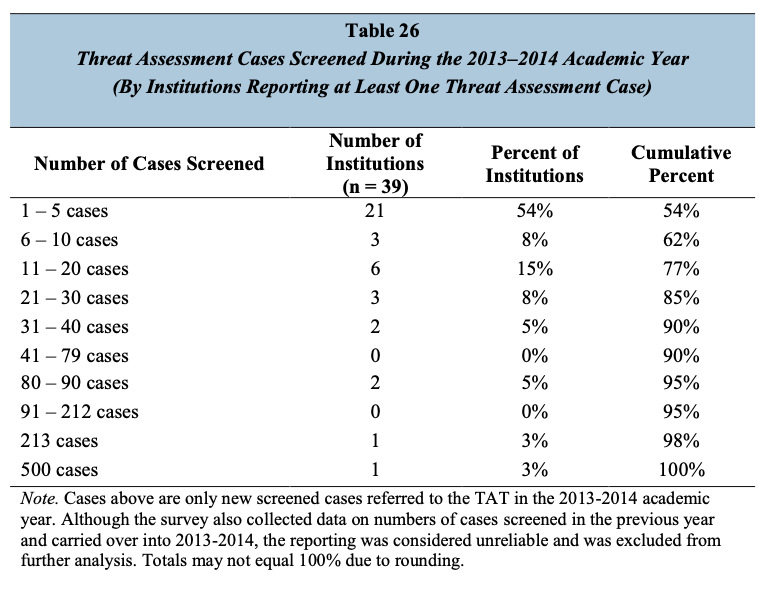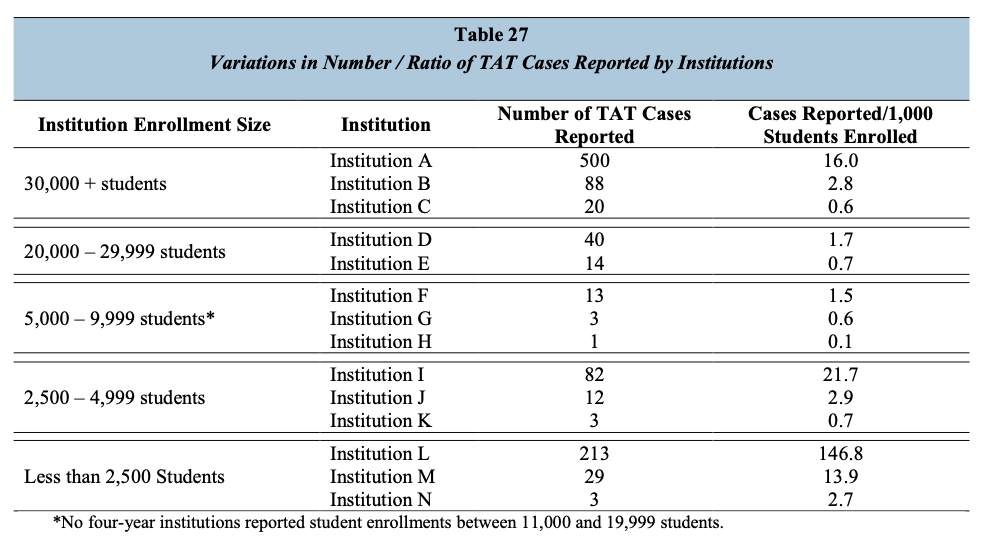I have written about the Threat Assessment Teams (TAT’s) of two state universities, the University of Virginia and Virginia Tech.
I assessed Tech to be compliant with state law. I reported that UVa is not. That of course raises the issue of the rest of Virginia’s colleges and universities.
The Virginia Department of Criminal Justice Services (DCJS) in 2014, with far more resources and access than I, found the state of the TAT’s serving the commonwealth’s fifteen four-year state institutions of higher learning (IHL), its community colleges and private IHLs to be as a group a hot mess (my term).
I will follow this article with an assessment of the compliance of the current policies of Virginia’s fifteen public IHLs.
The 2014 report did not have the intended effect of standardization and professionalization of threat assessment and intervention in Virginia. Preliminary reviews of the policies of each IHL show them still to be all over the map in terms of compliance.
I am reasonably sure that if DCJS redid its survey tomorrow, it would result in similar findings and recommendations. Perhaps at this point the government should actually enforce the law rather than just reporting on the lack of compliance.
One wishes that had occurred years earlier.
Background for DCJS report. The 2008 Virginia General Assembly passed legislation that required each public institution of higher education (IHE) to establish a violence prevention committee (VPC) and a threat assessment team (TAT).
Those two organizations were charged with preventing violence on campus by
- setting policy on the one hand; and
- assessing and intervening when individuals exhibit behavior which may pose a threat to the safety of the campus community on the other.
There is separate guidance in the law for the structure of a Violence Prevention Committee and a Threat Assessment Team at each public IHE.
Each Violence Prevention Committee (VPC) was then, as now, charged with specific responsibilities for setting policy, including
(a) the assessment of individuals whose behavior may present a threat,
(b) appropriate means of intervention with such individuals, and
(c) sufficient means of action, including interim suspension, referrals to community services boards or health care providers for evaluation or treatment, medical separation to resolve potential physical threats, and notification of family members or guardians, or both, unless such notification would prove harmful to the individual in question, consistent with state and federal law.
Each TAT, then as now, was required to implement the assessment, intervention, and action policies set forth by the VPC.
The DCJS worked with an earlier version of current law, but that version (§23-9.2:10. Violence prevention committee; threat assessment team) was not different in any meaningful respect from the current § 23.1-805.
DCJS in September of 2021 produced a study that indicated that Family Educational Rights and Privacy Act (FERPA) information was available to TATs, including the institutional police members of the TAT.
Findings and Recommendations. There is no question that changes appropriate to the findings could have been mandated at state IHLs immediately after the issuance of the 2014 study.
They were not. I have no idea why not.
Selected findings follow and are quoted in full.
The majority of the public institutions VPCs (about 70%) and TATs (about 75%) have the types of representation (student affairs, law enforcement, counseling services, etc.) on the committees required by §23-9.2:10. Community colleges appear slightly less likely than four-year public institutions to have all the required representation, but this may be due to overlapping or duplicate functions performed by the same person on the committees.
Regarding intervention strategies, institutional policies are most likely to include disciplinary conduct review, interim suspension, and voluntary referral for mental health services (all over 80%). Policies were least likely to include involuntary hospitalization (51%) or medical separation (45%), particularly for community colleges.
18% of institutions reported always using at least one assessment tool during their threat assessment process.
Almost two-thirds (64%) of the institutions reported having between five and 10 TAT members. The average number of team members was eight, the minimum was five members, and the maximum was 16 members.
The largest percentage of TATs were chaired by a student affairs representative (41%) followed by a law enforcement/public safety representative (27%).
Only seven four-year public institutions, one community college, and one private institution reported having a budget allocated specifically for threat assessment.
80% of four-year public institutions indicated that they have a mechanism for monitoring social media, as opposed to 47% of community colleges and 47% of private institutions.
91% of institutions reported that their TAT assessed one or more threat cases during the 2013- 2014 academic year. Four institutions reported no threat assessment cases during this period. A total of 1,217 threat assessment cases were reported.
The numbers of threat assessment cases reviewed during the 2013-2014 academic year varied greatly between institutions, as did the risk levels assigned to these cases by the institutions. This suggests that there are differences between institutions in how they define and report threats, and in how they assess their risk levels.
The survey responses published in the report are more interesting even than the findings. Take intervention strategies. Thirteen of 15 public institutions had intervention strategies that included interim suspension. Presumably those other two included UVa.
First policy required of the VPC:
Then execution of policy by the TAT:
Net of that, we can see that TAT’s followed policy. Including policy not compliant with the law.
If interim suspension was not part of policy, it was not used It was of course not used in the case of the UVa alleged shooter. And it is not mentioned in current UVa policy.
With all of that, if you still think there is some rhyme or reason attributed to the TAT process, look at this chart.
One institution with less than 2,500 students in 2013-14 academic year investigated 213 of them as potential threats. Another with over 30,000 investigated 20 in the same year. It is statistically nearly impossible they were using anything like the same criteria.
Bottom Line. Current law needs to be updated to define TATs as law enforcement activities, led by the Chief of Police, with a dedicated law enforcement investigator assigned, as Virginia Tech does, and with the statutory participation of mental health professionals and legal counsel.
Campus law enforcement officials should gather information available through law enforcement channels and FERPA information, investigate, execute searches, execute bans from the campus, and execute temporary suspensions.
The mental health professionals should execute mental health exams. Those in turn should be mandatory upon determination of the team.
Temporary suspensions for school safety should be automatic for those declining to participate in an investigation in any way.
The TAT should have access to other university/college resources for case-specific support, but the concept of leading threat assessment teams with student affairs personnel is preposterous and needs to stop.
Padding the TAT’s with other campus interest groups by statute or even voluntarily at best slows the process and is at worst counterproductive to the safety of the community.
There were, inexplicably, no directives issued to state institutions as a result of the shortfalls found in the DCJS study. Only recommendations.
Higher education administrators may wish to further examine the reasons why there are differences in compliance between Virginia’s community colleges and public four-year IHEs with certain aspects of the legislative requirements for TATs.
“May wish to.”
Clearly some did not wish to.
Virginia pre-K-12 public schools have very similar requirements. Wonder how they are doing?
Bottom line updated for clarity of intent for legislation Nov 22 at 15:11






Leave a Reply
You must be logged in to post a comment.